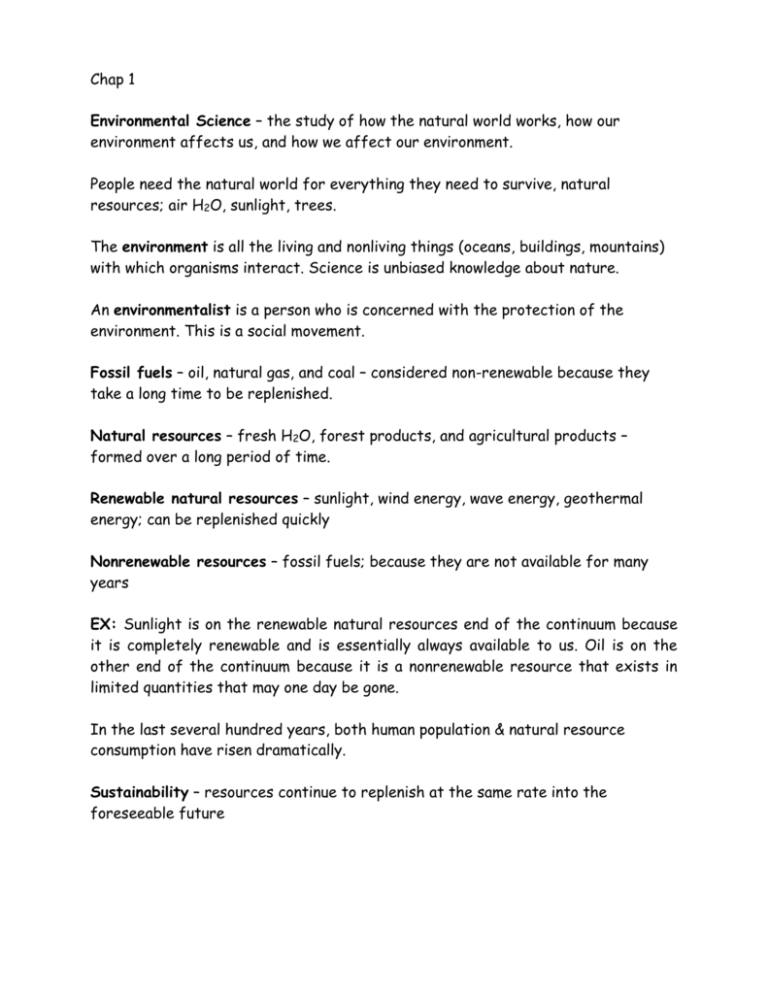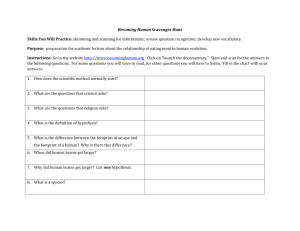Chap 1 Environmental Science – the study of how the natural world
advertisement

Chap 1 Environmental Science – the study of how the natural world works, how our environment affects us, and how we affect our environment. People need the natural world for everything they need to survive, natural resources; air H2O, sunlight, trees. The environment is all the living and nonliving things (oceans, buildings, mountains) with which organisms interact. Science is unbiased knowledge about nature. An environmentalist is a person who is concerned with the protection of the environment. This is a social movement. Fossil fuels – oil, natural gas, and coal – considered non-renewable because they take a long time to be replenished. Natural resources – fresh H2O, forest products, and agricultural products – formed over a long period of time. Renewable natural resources – sunlight, wind energy, wave energy, geothermal energy; can be replenished quickly Nonrenewable resources – fossil fuels; because they are not available for many years EX: Sunlight is on the renewable natural resources end of the continuum because it is completely renewable and is essentially always available to us. Oil is on the other end of the continuum because it is a nonrenewable resource that exists in limited quantities that may one day be gone. In the last several hundred years, both human population & natural resource consumption have risen dramatically. Sustainability – resources continue to replenish at the same rate into the foreseeable future What does it mean to do Science? – to conduct an experiment in a lab or out in the field. It is a process that involves observation, experimentation, and an analysis of quantitative data. Science is both a process of learning about the natural world and a summary of what scientists already have learned. To be an effective scientist one needs to actively seek evidence that provides answers to scientific questions and are open to results that change or even disprove a previously accepted idea. A hypothesis is a testable idea that attempts to explain a scientific question. A theory is broader than a hypothesis, dealing with a wider range of situations & observations tested over time. Scientific Method – Identify problem - question Gather information - data Hypothesis – a testable prediction Experiment – test your hypothesis Conclusion – was my hypothesis proven right or wrong? Communicate results – peer review Independent variable – I can change (cause) Dependent variable – gets its value from the independent variable (effect) Why is it important to control all variables except one when studying cause-and effect relationships? To be more confident that any differences observed were caused by the factor being investigated. Quantitative data – numbers Qualitative data – descriptive Why are quantitative data particularly helpful to scientists? Because numbers are precise and easy to compare. Controlled experiment – testing 1 thing at a time Alternative method scientists can use to gather data – observational studies, field studies & building a model (ABC hike – field study) Ethics – the branch of philosophy that involves the study of the good & the bad, and the right & the wrong Anthropocentrism – human-centered view of our environment Biocentrism – values all living things, non-human & human Ecocentrism – judges all actions in terms of their benefit or harm to the entire ecological system, both living & non-living & their relationships among them Ecological footprint - The environmental effects of an individual or population based on the amount of land and H2O needed for raw materials and for disposing of or recycling waste Correlation – A meaningful and predictable relationship among variables Carbon Footprint – recall the video “The Human Footprint” – define yours… Ozone – O3 – what are the dangers of UV radiation? Remember Slip, Slap, Slop, Wrap! Why do we need ozone – Where is it found – What does CFC stand for – What is the bad element in the mixture?











